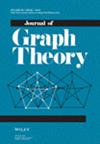On Tournament Inversion
IF 1
3区 数学
Q2 MATHEMATICS
Raphael Yuster
{"title":"On Tournament Inversion","authors":"Raphael Yuster","doi":"10.1002/jgt.23251","DOIUrl":null,"url":null,"abstract":"<p>An <i>inversion</i> of a tournament <span></span><math>\n <semantics>\n <mrow>\n \n <mrow>\n <mi>T</mi>\n </mrow>\n </mrow>\n </semantics></math> is obtained by reversing the direction of all edges with both endpoints in some set of vertices. Let <span></span><math>\n <semantics>\n <mrow>\n \n <mrow>\n <msub>\n <mtext>inv</mtext>\n \n <mi>k</mi>\n </msub>\n \n <mrow>\n <mo>(</mo>\n \n <mi>T</mi>\n \n <mo>)</mo>\n </mrow>\n </mrow>\n </mrow>\n </semantics></math> be the minimum length of a sequence of inversions using sets of size at most <span></span><math>\n <semantics>\n <mrow>\n \n <mrow>\n <mi>k</mi>\n </mrow>\n </mrow>\n </semantics></math> that result in the transitive tournament. Let <span></span><math>\n <semantics>\n <mrow>\n \n <mrow>\n <msub>\n <mtext>inv</mtext>\n \n <mi>k</mi>\n </msub>\n \n <mrow>\n <mo>(</mo>\n \n <mi>n</mi>\n \n <mo>)</mo>\n </mrow>\n </mrow>\n </mrow>\n </semantics></math> be the maximum of <span></span><math>\n <semantics>\n <mrow>\n \n <mrow>\n <msub>\n <mtext>inv</mtext>\n \n <mi>k</mi>\n </msub>\n \n <mrow>\n <mo>(</mo>\n \n <mi>T</mi>\n \n <mo>)</mo>\n </mrow>\n </mrow>\n </mrow>\n </semantics></math> taken over <span></span><math>\n <semantics>\n <mrow>\n \n <mrow>\n <mi>n</mi>\n </mrow>\n </mrow>\n </semantics></math>-vertex tournaments. It is well known that <span></span><math>\n <semantics>\n <mrow>\n \n <mrow>\n <msub>\n <mtext>inv</mtext>\n \n <mn>2</mn>\n </msub>\n \n <mrow>\n <mo>(</mo>\n \n <mi>n</mi>\n \n <mo>)</mo>\n </mrow>\n \n <mo>=</mo>\n \n <mrow>\n <mo>(</mo>\n \n <mrow>\n <mn>1</mn>\n \n <mo>+</mo>\n \n <mi>o</mi>\n \n <mrow>\n <mo>(</mo>\n \n <mn>1</mn>\n \n <mo>)</mo>\n </mrow>\n </mrow>\n \n <mo>)</mo>\n </mrow>\n \n <msup>\n <mi>n</mi>\n \n <mn>2</mn>\n </msup>\n \n <mo>∕</mo>\n \n <mn>4</mn>\n </mrow>\n </mrow>\n </semantics></math> and it was recently proved by Alon et al. that <span></span><math>\n <semantics>\n <mrow>\n \n <mrow>\n <mtext>inv</mtext>\n \n <mrow>\n <mo>(</mo>\n \n <mi>n</mi>\n \n <mo>)</mo>\n </mrow>\n \n <mo>≔</mo>\n \n <msub>\n <mtext>inv</mtext>\n \n <mi>n</mi>\n </msub>\n \n <mrow>\n <mo>(</mo>\n \n <mi>n</mi>\n \n <mo>)</mo>\n </mrow>\n \n <mo>=</mo>\n \n <mi>n</mi>\n \n <mrow>\n <mo>(</mo>\n \n <mrow>\n <mn>1</mn>\n \n <mo>+</mo>\n \n <mi>o</mi>\n \n <mrow>\n <mo>(</mo>\n \n <mn>1</mn>\n \n <mo>)</mo>\n </mrow>\n </mrow>\n \n <mo>)</mo>\n </mrow>\n </mrow>\n </mrow>\n </semantics></math>. In these two extreme cases (<span></span><math>\n <semantics>\n <mrow>\n \n <mrow>\n <mi>k</mi>\n \n <mo>=</mo>\n \n <mn>2</mn>\n </mrow>\n </mrow>\n </semantics></math> and <span></span><math>\n <semantics>\n <mrow>\n \n <mrow>\n <mi>n</mi>\n </mrow>\n </mrow>\n </semantics></math>), random tournaments are extremal objects. It is proved that <span></span><math>\n <semantics>\n <mrow>\n \n <mrow>\n <msub>\n <mtext>inv</mtext>\n \n <mi>k</mi>\n </msub>\n \n <mrow>\n <mo>(</mo>\n \n <mi>n</mi>\n \n <mo>)</mo>\n </mrow>\n </mrow>\n </mrow>\n </semantics></math> is <i>not</i> attained by random tournaments when <span></span><math>\n <semantics>\n <mrow>\n \n <mrow>\n <mi>k</mi>\n \n <mo>≥</mo>\n \n <msub>\n <mi>k</mi>\n \n <mn>0</mn>\n </msub>\n </mrow>\n </mrow>\n </semantics></math> and conjectured that <span></span><math>\n <semantics>\n <mrow>\n \n <mrow>\n <msub>\n <mtext>inv</mtext>\n \n <mn>3</mn>\n </msub>\n \n <mrow>\n <mo>(</mo>\n \n <mi>n</mi>\n \n <mo>)</mo>\n </mrow>\n </mrow>\n </mrow>\n </semantics></math> is (only) attained by (quasi)random tournaments. It is further proved that <span></span><math>\n <semantics>\n <mrow>\n \n <mrow>\n <mrow>\n <mo>(</mo>\n \n <mrow>\n <mn>1</mn>\n \n <mo>+</mo>\n \n <mi>o</mi>\n \n <mrow>\n <mo>(</mo>\n \n <mn>1</mn>\n \n <mo>)</mo>\n </mrow>\n </mrow>\n \n <mo>)</mo>\n </mrow>\n \n <msub>\n <mtext>inv</mtext>\n \n <mn>3</mn>\n </msub>\n \n <mrow>\n <mo>(</mo>\n \n <mi>n</mi>\n \n <mo>)</mo>\n </mrow>\n \n <mo>∕</mo>\n \n <msup>\n <mi>n</mi>\n \n <mn>2</mn>\n </msup>\n \n <mo>∈</mo>\n \n <mrow>\n <mo>[</mo>\n </mrow>\n \n <mfrac>\n <mn>1</mn>\n \n <mn>12</mn>\n </mfrac>\n \n <mo>,</mo>\n \n <mn>0.0992</mn>\n \n <mo>)</mo>\n </mrow>\n </mrow>\n </semantics></math> and <span></span><math>\n <semantics>\n <mrow>\n \n <mrow>\n <mrow>\n <mo>(</mo>\n \n <mrow>\n <mn>1</mn>\n \n <mo>+</mo>\n \n <mi>o</mi>\n \n <mrow>\n <mo>(</mo>\n \n <mn>1</mn>\n \n <mo>)</mo>\n </mrow>\n </mrow>\n \n <mo>)</mo>\n </mrow>\n \n <msub>\n <mtext>inv</mtext>\n \n <mi>k</mi>\n </msub>\n \n <mrow>\n <mo>(</mo>\n \n <mi>n</mi>\n \n <mo>)</mo>\n </mrow>\n \n <mo>∕</mo>\n \n <msup>\n <mi>n</mi>\n \n <mn>2</mn>\n </msup>\n \n <mo>∈</mo>\n \n <mrow>\n <mo>[</mo>\n \n <mrow>\n <mfrac>\n <mn>1</mn>\n \n <mrow>\n <mn>2</mn>\n \n <mi>k</mi>\n \n <mrow>\n <mo>(</mo>\n \n <mrow>\n <mi>k</mi>\n \n <mo>−</mo>\n \n <mn>1</mn>\n </mrow>\n \n <mo>)</mo>\n </mrow>\n </mrow>\n </mfrac>\n \n <mo>+</mo>\n \n <msub>\n <mi>δ</mi>\n \n <mi>k</mi>\n </msub>\n \n <mo>,</mo>\n \n <mfrac>\n <mn>1</mn>\n \n <mrow>\n <mn>2</mn>\n \n <mrow>\n <mo>⌊</mo>\n \n <mrow>\n <msup>\n <mi>k</mi>\n \n <mn>2</mn>\n </msup>\n \n <mo>∕</mo>\n \n <mn>2</mn>\n </mrow>\n \n <mo>⌋</mo>\n </mrow>\n </mrow>\n </mfrac>\n \n <mo>−</mo>\n \n <msub>\n <mi>ϵ</mi>\n \n <mi>k</mi>\n </msub>\n </mrow>\n \n <mo>]</mo>\n </mrow>\n </mrow>\n </mrow>\n </semantics></math>, where <span></span><math>\n <semantics>\n <mrow>\n \n <mrow>\n <msub>\n <mi>ϵ</mi>\n \n <mi>k</mi>\n </msub>\n \n <mo>></mo>\n \n <mn>0</mn>\n </mrow>\n </mrow>\n </semantics></math> for all <span></span><math>\n <semantics>\n <mrow>\n \n <mrow>\n <mi>k</mi>\n \n <mo>≥</mo>\n \n <mn>3</mn>\n </mrow>\n </mrow>\n </semantics></math> and <span></span><math>\n <semantics>\n <mrow>\n \n <mrow>\n <msub>\n <mi>δ</mi>\n \n <mi>k</mi>\n </msub>\n \n <mo>></mo>\n \n <mn>0</mn>\n </mrow>\n </mrow>\n </semantics></math> for all <span></span><math>\n <semantics>\n <mrow>\n \n <mrow>\n <mi>k</mi>\n \n <mo>≥</mo>\n \n <msub>\n <mi>k</mi>\n \n <mn>0</mn>\n </msub>\n </mrow>\n </mrow>\n </semantics></math>.</p>","PeriodicalId":16014,"journal":{"name":"Journal of Graph Theory","volume":"110 1","pages":"82-91"},"PeriodicalIF":1.0000,"publicationDate":"2025-04-22","publicationTypes":"Journal Article","fieldsOfStudy":null,"isOpenAccess":false,"openAccessPdf":"https://onlinelibrary.wiley.com/doi/epdf/10.1002/jgt.23251","citationCount":"0","resultStr":null,"platform":"Semanticscholar","paperid":null,"PeriodicalName":"Journal of Graph Theory","FirstCategoryId":"100","ListUrlMain":"https://onlinelibrary.wiley.com/doi/10.1002/jgt.23251","RegionNum":3,"RegionCategory":"数学","ArticlePicture":[],"TitleCN":null,"AbstractTextCN":null,"PMCID":null,"EPubDate":"","PubModel":"","JCR":"Q2","JCRName":"MATHEMATICS","Score":null,"Total":0}
引用次数: 0
Abstract
An inversion of a tournament is obtained by reversing the direction of all edges with both endpoints in some set of vertices. Let be the minimum length of a sequence of inversions using sets of size at most that result in the transitive tournament. Let be the maximum of taken over -vertex tournaments. It is well known that and it was recently proved by Alon et al. that . In these two extreme cases ( and ), random tournaments are extremal objects. It is proved that is not attained by random tournaments when and conjectured that is (only) attained by (quasi)random tournaments. It is further proved that and , where for all and for all .
关于比赛反转
一个锦标赛T的反转是通过反转所有边的方向,在一些顶点集合中有两个端点。设inv k (T)为最小长度使用大小不超过k的集合的反转序列,从而导致传递比武。设inv k (n)是的最大值invk (T)代入N顶点锦标赛。众所周知,inv2 (n) =(1 + 0 (1))) n∕4,最近由Alon等人证明Inv (n)是对象的集合(n) = n (1)+ 0 (1) 一个锦标赛T的反转是通过反转所有边的方向,在一些顶点集合中有两个端点。设inv k (T)为最小长度使用大小不超过k的集合的反转序列,从而导致传递比武。设inv k (n)是的最大值invk (T)代入N顶点锦标赛。众所周知,inv2 (n) =(1 + 0 (1))) n∕4,最近由Alon等人证明。 其中,inv (n)是对的(n) = n (1)+ 0 (1))。在这两种极端情况下(k = 2和n),随机比赛是极端目标。证明了invk (n)不是当k≥k 0时,通过随机比赛得到,并推测Inv 3 (n)只能通过(准)随机比赛获得。 进一步证明了(1 + 0)(1); (3)N)∕N 2∈[1,12,0。
本文章由计算机程序翻译,如有差异,请以英文原文为准。
求助全文
约1分钟内获得全文
求助全文
来源期刊

Journal of Graph Theory
数学-数学
CiteScore
1.60
自引率
22.20%
发文量
130
审稿时长
6-12 weeks
期刊介绍:
The Journal of Graph Theory is devoted to a variety of topics in graph theory, such as structural results about graphs, graph algorithms with theoretical emphasis, and discrete optimization on graphs. The scope of the journal also includes related areas in combinatorics and the interaction of graph theory with other mathematical sciences.
A subscription to the Journal of Graph Theory includes a subscription to the Journal of Combinatorial Designs .
相关文献
×
引用
GB/T 7714-2015
复制
MLA
复制
APA
复制
导出至
BibTeX
EndNote
RefMan
NoteFirst
NoteExpress
请完成安全验证×
微信好友
朋友圈
QQ好友
复制链接
取消

已复制链接
快去分享给好友吧!
我知道了

点击右上角分享
 求助内容:
求助内容: 应助结果提醒方式:
应助结果提醒方式:
